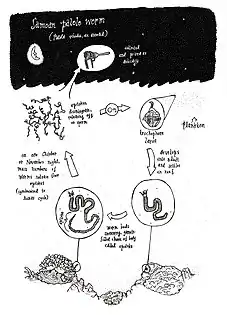Palola viridis
Palola viridis, commonly known as the palolo worm, Samoan palolo worm, wawo or nyale, is a Polychaeta species from the waters of some of the Pacific islands, including Samoa, Vanuatu, and the islands of the Malaysian Archipelago (Indonesia and the Philippines).
| Palola viridis | |
|---|---|
 | |
| Scientific classification | |
| Kingdom: | |
| Phylum: | |
| Class: | |
| Order: | |
| Family: | |
| Genus: | Palola |
| Species: | P. viridis |
| Binomial name | |
| Palola viridis (Gray, 1840) | |
| Synonyms | |
|
Eunice viridis | |
Life cycle

Reproduction involves mass spawning at night in spring or early summer (October – November in the Southern Hemisphere). The terminal parts of their bodies drop off and float over the surface of the water, releasing sperm and eggs. The mechanisms or triggers which induce spawning such that it occurs during nights of a waning moon, continuing for several nights, are not completely known.[1][2] Exposure to sunlight destroys this "tail" part of the worm's body afterwards.[3]
Taxonomy
It is sometimes synonymous with Palola siciliensis.
Distribution
The palolo worm is found in tropical regions around various islands of the Pacific Ocean, including Samoa, Indonesia, Vanuatu, and some islands of the Philippines. They are variously known as the palolo worm, wawo or nyale (Indonesia).[3][4][5][1][6][7][8]
Cultural use

Some Indigenous populations in regions where palolo occur use the reproductive portion of the worm as a food source. During their short-lived annual appearance in the last quarter of the moon in October and November, worms are gathered with nets or buckets, and are either eaten raw or cooked in several different ways.
In Samoa, the worms are revered as a great delicacy, with hunting for them taking place seven days after the first full moon in October. Often bright blue in colour, the flavour is said to resemble a cross between mussels, abalone and oysters. They are sometimes eaten fresh, but usually fried with butter and onions and served with taro or banana chips. The palolo harvest is part of the culture and tradition of Samoans, where the feast is shared with family and relatives, but in recent years has been sold in the markets of Apia and Salelologa for more than A$100 per kilogram.[3]
On the island of Lombok in Indonesia, a traditional event called the Nyale Festival, or Bau Nyale (meaning "to catch the sea worms[5]), is held between February and March. The event focuses on catching these worms, which are known as wawo.[6][5] In local legend, the nyale are believed to be the reincarnation of Princess Mandalika, who had jumped into the sea to drown herself.[9]
The spawning event is so important to the inhabitants of the Torres and Banks Islands of Vanuatu that it is featured in their lunar calendar.[10]
Notes
- Craig, P. "Natural History Guide to American Samoa" (PDF). National Park of American Samoa, Department Marine and Wildlife Resources, American Samoa Community College. Retrieved 16 August 2009.
- Ley, Willy (October 1960). "The Moon Worm". For Your Information. Galaxy Science Fiction. pp. 56–66.
- Aualiitia, Tahlea (10 October 2020). "It's palolo season in Samoa and locals have just a few nights to hunt for this ocean delicacy". ABC News. Australian Broadcasting Corporation. Retrieved 10 October 2020.
- "EUNICIDAE - Eunice species". Poppe Images: Marine Iconography of the Philippine Archipelago. Retrieved 11 October 2020.
- "Bau Nyale… Lombok's Unique Festival". Bali Advertiser. Retrieved 11 October 2020.
- Nugraha, Panca (10 February 2020). "More than sea worms: Bau Nyale seeks to charm tourists with legends, festivities". The Jakarta Post. Retrieved 11 October 2020.
- "Wawo and Palolo Worms". Nature. 21 April 1904. Retrieved 11 October 2020.
- Pamungkas, Joko (27 February 2015). "Species richness and macronutrient content of wawo worms (Polychaeta, Annelida) from Ambonese waters, Maluku, Indonesia". Biodiversity Data Journal. 3. doi:10.3897/BDJ.3.e4251. ISSN 1314-2828. Retrieved 11 October 2020. (Also via PMC)
- "The Exciting Bau Nyale Festival 2018 in the Enchanting Lombok Island". Indonesia Travel. Retrieved 11 October 2020.
- Codrington (1891); Mondragón (2004).
References
- World Conservation Monitoring Centre (1996). "Eunice viridis". IUCN Red List of Threatened Species. 1996: e.T8261A12903350. doi:10.2305/IUCN.UK.1996.RLTS.T8261A12903350.en.
- Codrington, Robert (1891). The Melanesians: Studies in their Anthropology and Folk-Lore. Oxford: Clarendon Press.
- Mondragón, Carlos (June 2004). "Of Winds, Worms and Mana: The Traditional Calendar of the Torres Islands, Vanuatu". Oceania. 74 (4): 289–308. doi:10.1002/j.1834-4461.2004.tb02856.x. JSTOR 40332069.
- Gill, Rev Mr. (1854). "On the Palolo". Edinburgh New Philosophical Journal. 57. Retrieved 4 January 2018.
External links
- Image of the head of a palolo worm from the Smithsonian Institution
- Samoa Worm Sperm Spawns Annual Fiesta from National Geographic
- The Lunar Calendar of the Banks Islands
